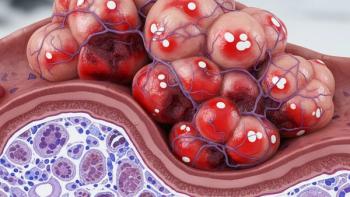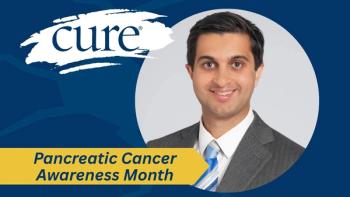
Artistic Roots and Caregiving: A Calendar Contest Winner’s Story
Key Takeaways
- Gail Durant's painting symbolizes her family's history and resilience through cancer battles, with personal elements like a white dove representing her late mother.
- Durant's family faced multiple cancer diagnoses, including her mother and husband, highlighting the emotional and caregiving challenges she endured.
The artwork of Gail Durant, winner of the annual CURE Calendar Contest, captured the heart of her family’s connection to home and the cancer journey.
When Gail Durant submitted her holiday-themed ornament painting, "Mom's Old House," to the CURE 2026 Calendar Contest, she wasn't just sending in a piece of art; she was sharing a half-century of family history, love, and loss. Rich with personal symbolism, from the little red gate of her childhood projects to the white dove representing her late mother, Durant’s painting is a powerful testament to the roots that anchor a family through the storm of cancer and the healing power of turning grief into creation.
In an interview with CURE, Durant shared the story behind her symbolic artwork, the numerous ways cancer has impacted her and her family’s live, and the little signs from above that life shows you along the way.
CURE: Before we discuss your artwork, please discuss your personal connection to cancer.
Durant: Cancer has heavily impacted our family. I’m from a family of 13, but one of my younger sisters, Brenda, died of pneumonia, so there were 12 of us for many years.
I never graduated high school, but I’ve always been creative. I’ve won many contests and accumulated four albums worth of awards. I started painting three years ago after finding an instructor online. She encourages us to put our own spin on the projects, and when she suggested an ornament, I thought, "What can I do?" Mom's old house came to mind, and that led me to the memory of our family’s experience with cancer.
Let me start with my mother. Her journey with squamous cell carcinoma of the lung was only eight weeks long. My brother had adenocarcinoma of the lung; his journey was about a year. My brother Michael had three types of cancer over a three-year journey. They are all gone, including my mother. My husband, Bob, had glioblastoma, and his journey was one year and nine months. We used to go to Dartmouth-Hitchcock Medical Center in Lebanon, New Hampshire, all the time.
I quit work early (I’m a big believer in signs) and something told me to leave work at age 56. We moved to our lake house, and I took care of him.
Looking at the artwork, it is very evident that there is a big story behind that house.
My mother always said she didn't want to be a burden to bury. My father left my mother to raise all 12 kids, and she brought us up.
Years later, my mother met a wonderful man who moved her out of the projects and into his home when I was about 15. That house, the one in my painting, became the center of our lives. When that man died, my mom got ownership. Because she was on welfare, she couldn’t own property, so my uncle took over, bought the house and let her stay there — paying rent for years. When my uncle passed, it went to my aunt. Just last year, my youngest sister was finally able to purchase it, keeping the house in the family for over 55 years. She always said she’d get that house someday.
The painting represents home. I made sure to include a white dove in the artwork because my mother fed the birds every day, and whenever a white dove came, she’d say, "There's a white dove out there." I looked [white dove] up; it represents purity, like the Mother Mary. I always thought of my mother as a white dove.
It was always the place for Christmas and Thanksgiving. We would have 60 to 70 people there at once, eating at staggered tables in the kitchen and dining room because we couldn't all fit. Mom kept everyone together.
Before my sister bought the house, I made sure to bring my camera to take pictures because I knew I wanted to put Mom’s old house in my ornament painting. I even included the little red gate in front; you had to unlock it to get in because things often got stolen off the porch. We didn’t have trees in the front when we were kids, so after she died, we planted three apple trees, and some of her ashes are there. She was so proud to have raised us in that home.
Your passion comes through in your artwork and your storytelling.
Thank you. When my husband died, I had to ensure I fulfilled his last wish. We were at [Dartmouth-Hitchcock Medical Center in Lebanon], and he couldn’t talk, but I asked him, "Can I give $10,000 to brain cancer research?" He gave me a thumbs-up. I made sure I did that because they took such good care of him there.
The painting contest I entered with the lady who teaches me (she has 300,000 subscribers) she showed us how to paint the Santa Claus hand and the circle for the ornament. We had to figure out what to put in it, and Mom and that house just came up. We always go back to our roots.
You mentioned being a writer. You said you wrote a book about signs?
Yes, I wrote a love story about my husband and me and his cancer journey —what we went through and things I felt. The book is called Soul Signs From the Other Side. I just think people should know how to find their own signs after the loss of a loved one.
I took care of my husband for a year and nine months, feeding him, washing him, bathing him. It's a journey. My best friend was diagnosed with the same thing, glioblastoma, less than a year after my husband died. I was able to help guide her husband because I knew what to do, like suggesting mattress pads because sometimes my husband couldn't make it to the bathroom. I did everything I could to protect my husband and my mother.
I have a story about one of the signs in my book. After my husband died, I kept praying, "Should I write a book? Should I help orphans?" I asked God and Bob to send me a sign. Four months later, AARP ran a contest for a 200-word essay about your town. The third time I saw the ad, I realized I had to write the essay. I wrote it, forgot about it, and in January, I got an email: "Congratulations, you're an AARP winner!" I thought I'd won an iPod, but I opened it up (I won the grand prize of $10,000. The day I got the email was January 12th) the date I met my husband. That was my sign to write the book, and I used that money to write it. I gave all the money away to foster care and orphanages.
I try to live every day by my mantra: "Today is going to be a picture-perfect day, positive and in every way." I say it every day when I get in the shower because I want my day to be positive.
Transcript has been edited for length and clarity.
For more news on cancer updates, research and education,





